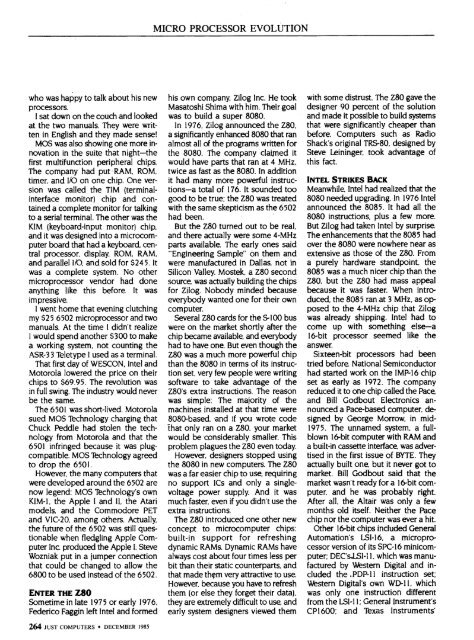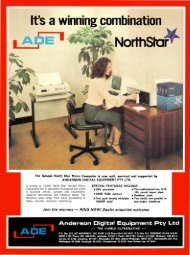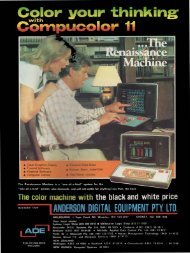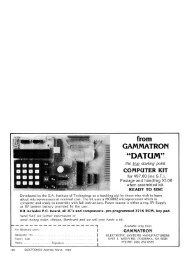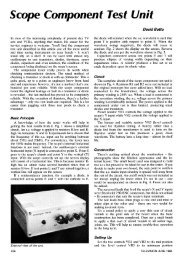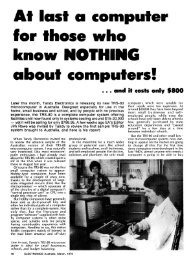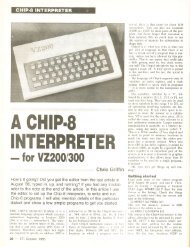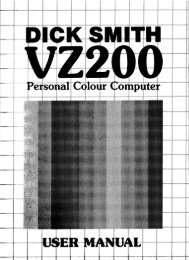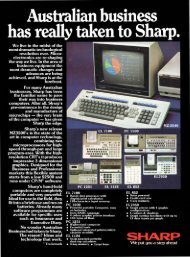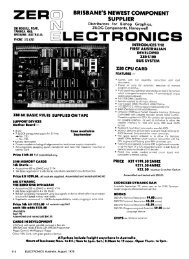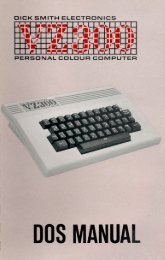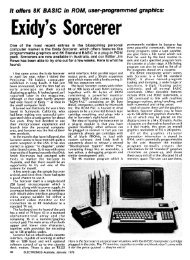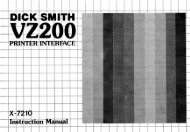History of Micro-Computers - The MESSUI Place
History of Micro-Computers - The MESSUI Place
History of Micro-Computers - The MESSUI Place
Create successful ePaper yourself
Turn your PDF publications into a flip-book with our unique Google optimized e-Paper software.
MICRO PROCESSOR EVOLUTIONwho was happy to talk about his newprocessors.I sat down on the couch and lookedat the two manuals. <strong>The</strong>y were writtenin English and they made sense!MOS was also showing one more innovationin the suite that night—thefirst multifunction peripheral chips.<strong>The</strong> company had put RAM, ROM,timer, and I/O on one chip. One versionwas called the TIM (terminalinterfacemonitor) chip and containeda complete monitor for talkingto a serial terminal. <strong>The</strong> other was theKIM (keyboard-input monitor) chip,and it was designed into a microcomputerboard that had a keyboard, centralprocessor, display, ROM, RAM,and parallel I/O, and sold for $245. Itwas a complete system. No othermicroprocessor vendor had doneanything like this before. It wasimpressive.I went home that evening clutchingmy $25 6502 microprocessor and twomanuals. At the time I didn't realizeI would spend another $300 to makea working system, not counting theASR-3 3 Teletype I used as a terminal.That first day <strong>of</strong> WESCON, Intel andMotorola lowered the price on theirchips to $69.95. <strong>The</strong> revolution wasin full swing. <strong>The</strong> industry would neverbe the same.<strong>The</strong> 6501 was short-lived. Motorolasued MOS Technology charging thatChuck Peddle had stolen the technologyfrom Motorola and that the6501 infringed because it was plugcompatible.MOS 'Technology agreedto drop the 6501.However, the many computers thatwere developed around the 6502 arenow legend: MOS Technology's ownKIM-1, the Apple I and II, the Atarimodels, and the Commodore PETand VIC-20, among others. Actually,the future <strong>of</strong> the 6502 was still questionablewhen fledgling Apple ComputerInc. produced the Apple I. SteveWozniak put in a jumper connectionthat could be changed to allow the6800 to be used instead <strong>of</strong> the 6502.ENTER THE Z80Sometime in late 1975 or early 1976,Federico Faggin left Intel and formed264 JUST COMPUTERS • DECEMBER 1985his own company, Zilog Inc. He tookMasatoshi Shima with him. <strong>The</strong>ir goalwas to build a super 8080.In 1976, Zilog announced the Z80,a significantly enhanced 8080 that ranalmost all <strong>of</strong> the programs written forthe 8080. <strong>The</strong> company claimed itwould have parts that ran at 4 MHz,twice as fast as the 8080. In additionit had many more powerful instructions—atotal <strong>of</strong> 176. It sounded toogood to be true; the Z80 was treatedwith the same skepticism as the 6502had been.But the Z80 turned out to be real,and there actually were some 4-MHzparts available. <strong>The</strong> early ones said"Engineering Sample" on them andwere manufactured in Dallas, not inSilicon Valley. Mostek, a Z80 secondsource, was actually building the chipsfor Zilog. Nobody minded becauseeverybody wanted one for their owncomputer.Several Z80 cards for the S-100 buswere on the market shortly after thechip became available, and everybodyhad to have one. But even though theZ80 was a much more powerful chipthan the 8080 in terms <strong>of</strong> its instructionset, very few people were writings<strong>of</strong>tware to take advantage <strong>of</strong> theZ80's extra instructions. <strong>The</strong> reasonwas simple: <strong>The</strong> majority <strong>of</strong> themachines installed at that time were8080-based, and if you wrote codethat only ran on a Z80, your marketwould be 'considerably smaller. Thisproblem plagues the Z80 even today.However, designers stopped usingthe 8080 in new computers. <strong>The</strong> Z80was a far easier chip to use, requiringno support ICs and only a singlevoltagepower supply. And it wasmuch faster, even if you didn't use theextra instructions.<strong>The</strong> Z80 introduced one other newconcept to microcomputer chips:built-in support for refreshingdynamic RAMs. Dynamic RAMs havealways cost about four times less perbit than their static counterparts, andthat made th(pm very attractive to use.However. because you have to refreshthem (or else they forget their data),they are extremely difficult to use, andearly system designers viewed themwith some distrust. <strong>The</strong> Z80 gave thedesigner 90 percent <strong>of</strong> the solutionand made it possible to build systemsthat were significantly cheaper thanbefore. <strong>Computers</strong> such as RadioShack's original TRS-80, designed bySteve Leininger, took advantage <strong>of</strong>this fact.INTEL STRIKES BACKMeanwhile Intel had realized that the8080 needed upgrading. In 1976 Intelannounced the 8085. It had all the8080 instructions, plus a few more.But Zilog had taken Intel by surprise.<strong>The</strong> enhancements that the 8085 hadover the 8080 were nowhere near asextensive as those <strong>of</strong> the Z80. Froma purely hardware standpoint, the8085 was a much nicer chip than theZ80, but the Z80 had mass appealbecause it was faster. When introduced,the 8085 ran at 3 MHz, as opposedto the 4-MHz chip that Zilogwas already shipping. Intel had tocome up with something else—a16-bit processor seemed like theanswer.Sixteen-bit processors had beentried before. National Semiconductorhad started work on the IMP-I6 chipset as early as 1972. <strong>The</strong> companyreduced it to one chip called the Pace.and Bill Godbout Electronics announceda Pace-based computer, designedby George Morrow, in mid-1975. <strong>The</strong> unnamed system. a fullblown16-bit computer with RAM anda built-in cassette interface, was advertisedin the first issue <strong>of</strong> BYTE. <strong>The</strong>yactually built one, but it never got tomarket. Bill Godbout said that themarket wasn't ready for a 16-bit computer,and he was probably right.After all, the Altair was only a fewmonths old itself. Neither the Pacechip nor the computer was ever a hit.Other 16-bit chips included GeneralAutomation's LSI-16, a microprocessorversion <strong>of</strong> its SPC-16 minicomputer;DEC's-LSI-11, which was manufacturedby Western Digital and includedthe .PDP-11 instruction set;Western Digital's own WD-11, whichwas only one instruction differentfrom the LS1-11; General Instrument'sCP1600; and 'Texas Instruments'


